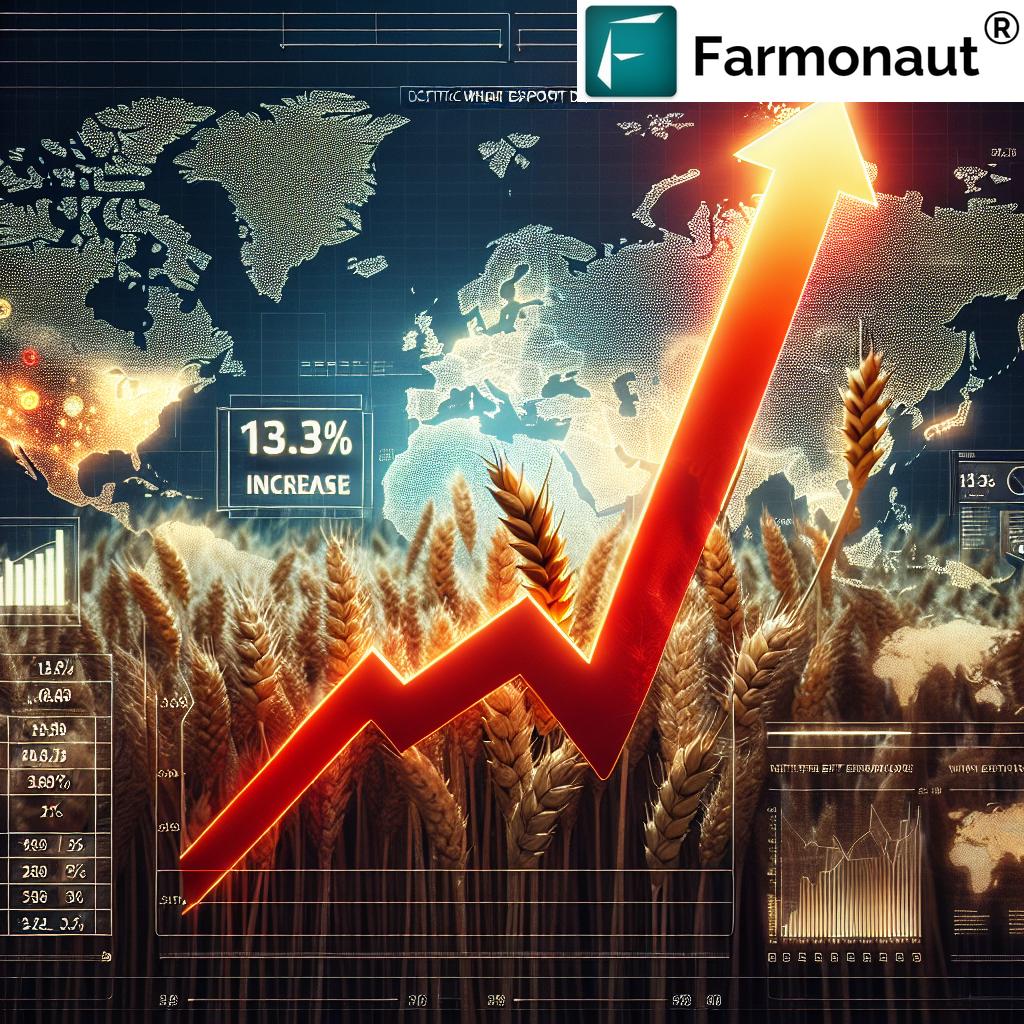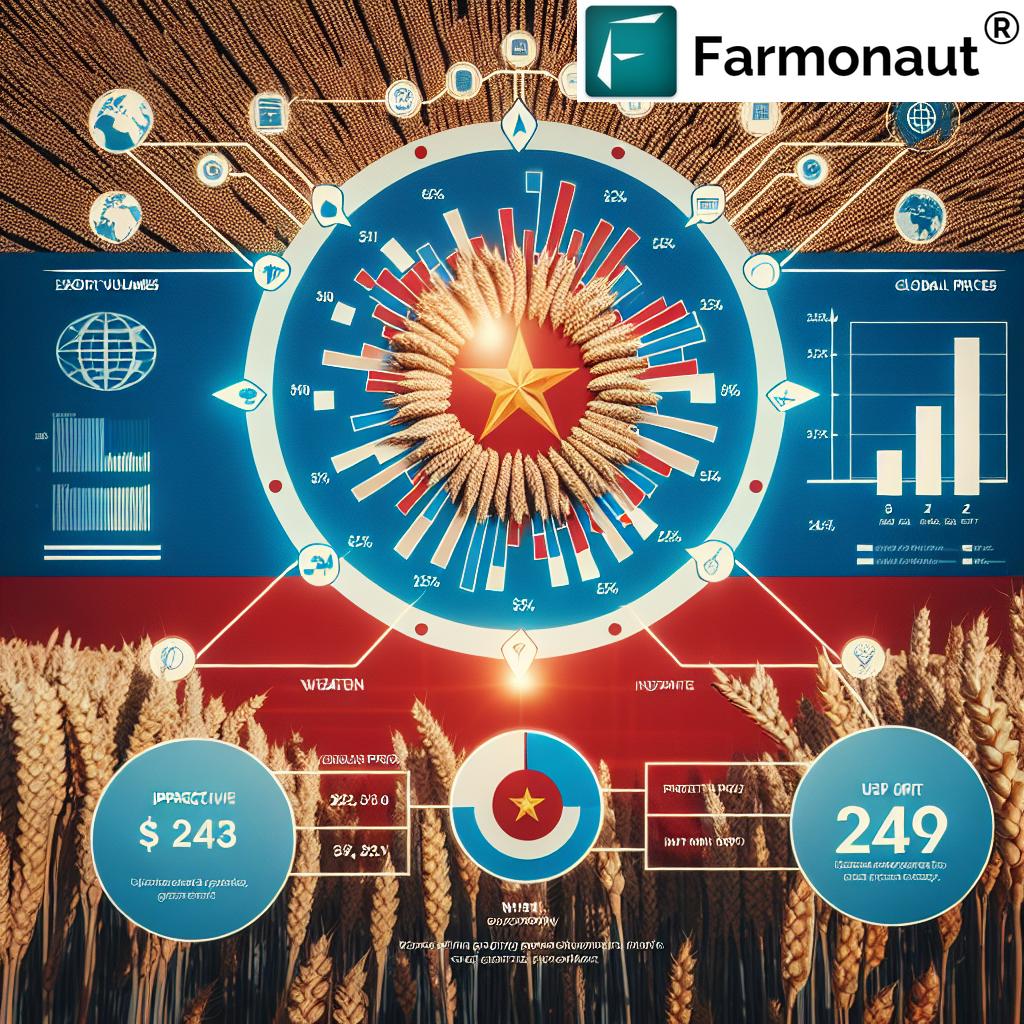Shocking Surge: Russian Wheat Export Duty Skyrockets 13.3% – Market Upheaval Looms
In a startling development that’s sending ripples through the global agricultural commodity market, Russia’s wheat export duty is set to surge by an unprecedented 13.3%, reaching 2,121 rubles per tonne. This dramatic shift in Russian wheat export duty is poised to reshape the landscape of international grain trade and spark significant Russian grain market changes.

Understanding the Russian Wheat Export Duty Increase
The recent adjustment in wheat export tariffs Russia is part of a broader strategy known as the grain damper mechanism. This mechanism, implemented by the Russian government, aims to stabilize domestic grain prices and ensure food security within the country. The current increase reflects the dynamic nature of the Russian grain market and its response to global economic factors.
- The new export duty: 2,121 rubles per tonne
- Percentage increase: 13.3%
- Previous export duty: 1,872.5 rubles per tonne
This significant hike in export duties is likely to have far-reaching consequences for both domestic and international wheat markets. As Russia is one of the world’s largest wheat exporters, any changes in its export policies can trigger a domino effect on global agricultural commodity prices.
Moscow Exchange Grain Prices: A Key Driver
The surge in Russian wheat export duty is closely tied to the recent uptick in wheat prices on the Moscow Exchange. According to the latest data, wheat prices have climbed to $217.4 per tonne, a significant increase that has directly influenced the calculation of export tariffs.
The Moscow Exchange grain prices serve as a crucial benchmark for the Russian agricultural sector and play a pivotal role in shaping export policies. As these prices fluctuate, they trigger adjustments in the grain damper mechanism, leading to changes in export duties for various grains.
Contrasting Trends: Barley and Corn Export Duties
While wheat export duties are on the rise, it’s important to note that the Russian grain market changes are not uniform across all grains. In contrast to wheat, both barley and corn are seeing a decrease in their export duties:
- Barley: Export duty reduced to 1,130.6 rubles per tonne
- Corn: Corn export duties lowered to 2,206.2 rubles per tonne
These divergent trends in grain export tariffs highlight the complex nature of Russia’s agricultural export strategy and its attempt to balance various market forces.

The Grain Damper Mechanism: Stabilizing the Market
The grain damper mechanism is a sophisticated policy tool employed by the Russian government to regulate grain exports and stabilize domestic prices. This mechanism adjusts export duties based on market conditions, primarily influenced by the Moscow Exchange grain prices.
The grain damper mechanism impact is multifaceted:
- Protects domestic consumers from price volatility
- Ensures a steady supply of grain for the internal market
- Regulates export volumes to maintain market balance
- Generates revenue for agricultural subsidies Russia
By implementing this mechanism, Russia aims to strike a delicate balance between supporting its agricultural sector and maintaining its position as a major player in the global grain trade.
Russian Agricultural Export Trends: A Broader Perspective
The recent changes in wheat export duties are part of a larger pattern of Russian agricultural export trends. Over the past few years, Russia has emerged as a dominant force in the global wheat market, often competing with traditional exporters like the United States and Canada.
Key factors influencing these trends include:
- Favorable climate conditions in key wheat-growing regions
- Investments in agricultural technology and infrastructure
- Government support through subsidies and export policies
- Fluctuations in global demand and supply dynamics
Understanding these trends is crucial for stakeholders in the global grain market, from traders and importers to policymakers and farmers.
Explore Farmonaut’s Satellite API for Agricultural Insights
Impact on Global Agricultural Commodity Prices
The surge in Russian wheat export duty is expected to have significant ramifications for global agricultural commodity prices. As Russia is a major wheat exporter, any increase in its export tariffs can lead to:
- Higher wheat prices in international markets
- Increased competition among other wheat-exporting nations
- Potential shifts in global trade patterns
- Ripple effects on related commodities like flour and bread
These changes underscore the interconnected nature of global agricultural markets and the far-reaching impact of policy decisions in major producing countries.
Russian Wheat Market Update: Current State and Future Outlook
As we delve into the latest Russian wheat market update, several key points emerge:
- Production levels remain robust despite challenging weather conditions in some regions
- Domestic consumption is stable, with a slight increase in feed use
- Export volumes are expected to adjust in response to the new tariffs
- Market participants are closely monitoring government policies and global demand
The future outlook for the Russian wheat market will depend on various factors, including weather patterns, global economic conditions, and geopolitical developments.
Access Farmonaut’s API Developer Docs for Advanced Agricultural Data
Navigating Market Fluctuations: The Role of Precision Agriculture
In light of these market changes, farmers and agricultural businesses must adapt to remain competitive. This is where precision agriculture solutions, such as those offered by Farmonaut, come into play. By leveraging satellite-based crop monitoring and data-driven insights, farmers can:
- Optimize crop yields to maximize profitability
- Reduce input costs through targeted resource application
- Make informed decisions based on real-time market and agronomic data
- Mitigate risks associated with market volatility and climate change
Farmonaut’s suite of tools empowers farmers to navigate the complexities of the global grain market with greater confidence and precision.
Conclusion: Adapting to a Changing Landscape
The recent surge in Russian wheat export duty marks a significant moment in the global agricultural landscape. As market participants grapple with these changes, staying informed and leveraging advanced agricultural technologies will be crucial for success.
Whether you’re a farmer, trader, or policymaker, understanding the nuances of Russian wheat market trends and their global implications is essential. By embracing precision agriculture solutions and staying abreast of market developments, stakeholders can turn challenges into opportunities in this ever-evolving sector.
As we move forward, the interplay between government policies, market forces, and technological advancements will continue to shape the future of global agriculture. Stay tuned for further updates on this developing story and its impact on the world of grain trade.















